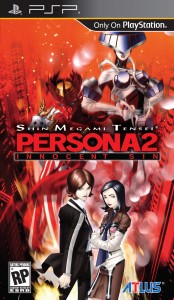 Have you heard the rumor about this organization that is giving out masks and then using crystal skulls to turn these people into emotionless ‘shadow people� Oh and some say Adolf Hitler is involved. This may sound like story to a wild action movie, but it is the setting to Persona 2: Innocent Sin.
Have you heard the rumor about this organization that is giving out masks and then using crystal skulls to turn these people into emotionless ‘shadow people� Oh and some say Adolf Hitler is involved. This may sound like story to a wild action movie, but it is the setting to Persona 2: Innocent Sin.
Persona 2: Innocent Sin came out in Japan in 1999 for the PS1. Two years later, Atlus made Persona 2: Eternal Punishment which came out in North America. Fans loved this game so much that they wanted Innocent Sin. At first, Atlus said that there would be no NA release due to its controversial content. Twelve years later, Atlus has finally released it in NA on the PSP.
Is it worth the wait?
It depends on how you approach the game.
In the fictional Japanese city of Sumaru City, rumors are becoming reality. One of these rumors centers around a mythical character named Joker, who will appear to you and make your dream come true if you dial your cell phone number- on your own cell phone. There’s also an organization that are giving people masks and using crystal skulls to take away people’s dreams and making them emotionless “shadow people.” Enter Tatsuya Suou, a high school student at Seven Sisters High who, along with his friends, Lucy and Eikichi and journalist Maya and Yukino from Persona 1, awake his persona and investigate these rumors.
What happens is a series that may be too much for even a person with a persona to handle.
The story is Persona 2: Innocent Sin’s greatest strength. The characters are well-developed and likeable, even Eikichi, despite being an egotistical, narcissistic brat. Atlus’s distinct blend of making ordinary people go into extraordinary circumstances with creatures from every myth imaginable, with some kind of mystery behind it, will keep players wanting to know what happens next. The addition of characters from Persona 1 making appearances, even making one of them playable, is a nice touch.
Throw Adolf Hitler into the mix and you’ll get one of the best stories in video games.
Some new Persona fans may go into this game thinking it will be like Persona 3 or 4. Instead, they get a traditional RPG with no daily schedule and a battle system that is much slower than what they are used to. This may disappoint some new fans expecting another Persona 3 or 4. The battle system is more like Persona 1 where you have to input command to all characters each round and watch what happens.
Unlike Persona 1, where a character must stand in a certain place to hit an enemy, here, characters can attack any enemy. No more are there two weapons per character, but one per character which makes it much easier to buy equipment for each of them. The addition of fusion spells is a great element to combat. These spells dish out a ton of damage and will be your ace in the hole in combat.
Speaking with the enemy, a Shin Megami Tensei stable, is in Persona 2: IS, but with a little twist. Each character has their own ways of communicating with the enemy and each will react differently to one another. This is the only way to get card from enemies which you can use to summon new personas in the velvet room. At first this may sound tedious but it becomes a fun experience and a much better way of ending a fight.
Then there’s the rumor system. Throughout Sumaru city there are “rumor mongers,†who will give you rumors to various shops that will sell weapons, armor and items. Depending on which rumor you ask the Kuzunoha Detective Agency to spread the items available at these shops will be different. Also, certain side-quests can only be accessed by spreading a rumor about it. This is a clever way to shape how you want each store to be depending on your preferences. Climax Theater is one of these side-quests which are the characters put in different situations all across the city where they must fix whatever problem is there. These quests are fun side missions, but are only recommended at higher levels because of their high difficulty.
The technical aspects of the game are a mixed bag. The graphics may look dated but twelve years ago these graphics were some of the best on the PS1. Aesthetically speaking, the character models are gorgeous. Atlus’s artwork is always a crowd pleaser. The music is hit or miss. Some songs are very good but then some songs are just not good and are forgettable. The remixed songs are not worth a listen at all. The new opening theme is okay, though it does fit in with the rest of the game.
The only major complaint about this game is the extremely high random encounter rate. You only walk for what seems twenty feet and then, you’re engaged in battle. After Persona 3 and 4’s method of seeing the enemy on screen and fighting them [if you want to a high random encounter rate], this will make players want to just set the difficulty to easy and just put the battle command on auto. Good thing you can save anywhere and the battles aren’t too tough. Or else some gamers will just quit.
After all that, Persona 2: Innocent Sin can only be recommended to fans of the Shin Megami Tensei franchise. It’s not a terrible game by any means, but the old school gameplay will put off some newer gamers.

Leave a Reply